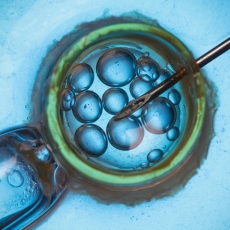
Assisted reproductive technology (ART) is used to treat infertility. It includes fertility treatments that handle both eggs and sperm. It works by removing eggs from the ovaries. The eggs are then mixed with sperm to make embryos. The embryos are then put back in the parent's body. In vitro fertilization (IVF) is the most common and effective type of ART.
ART procedures sometimes use donor eggs, donor sperm, or previously frozen embryos. It may also involve a surrogate or gestational carrier. A surrogate is a person who becomes pregnant with sperm from one partner of the couple. A gestational carrier becomes pregnant with an egg from one partner and sperm from the other partner.
- Assisted Reproductive Technology (National Library of Medicine)Assisted reproductive technology (ART) is used to treat infertility. It includes fertility treatments that handle both eggs and sperm. It works by removing eggs ...
- Arts syndrome is a disorder that causes serious neurological problems in males. Females can also be affected by ... they typically have much milder symptoms.Boys with Arts syndrome have profound sensorineural hearing loss, which is a ...
- ... gene mutations have been identified in people with Arts syndrome, a disorder that causes serious neurological problems in ... milder symptoms.The PRPS1 gene mutations that cause Arts syndrome change single protein building blocks (amino acids) in ...
- ... Noreuil K, Kukolich MK, Adam MP, Westra SJ, Arts HH. Sensenbrenner syndrome (Cranioectodermal dysplasia): clinical and molecular analyses of 39 ...
- ... Hoefsloot LH, Jongmans MC, Hofstra RM, van Ravenswaaij-Arts CM. CHD7 mutations and CHARGE syndrome: the clinical implications of an expanding phenotype. J ...
- ... Hoefsloot LH, Jongmans MC, Hofstra RM, van Ravenswaaij-Arts CM. CHD7 mutations and CHARGE syndrome: the clinical implications of an expanding phenotype. J ...
- HIV/Reference Desk ... HIV ... National Institutes of Health, Office of AIDS Research ... From the National Institutes of Health ... The seven stages of the HIV life cycle ...
- Hearing Problems in Children/Specifics ... Hearing Problems in Children ... Thyroid Diseases/Related Issues ... Thyroid Diseases ... National Institute on Deafness and Other ...
- ... Aug;54(8):2674-87. doi: 10.1002/art.21964. Citation on PubMed Rezaei N. TNF-receptor-associated periodic syndrome (TRAPS): an autosomal dominant multisystem disorder. Clin Rheumatol. ...
- ... M, Zuberi SM, De Vivo DC. Glut1 Deficiency Syndrome (Glut1DS): State of the art in 2020 and recommendations of the international Glut1DS study group. Epilepsia Open. 2020 Aug 13;5(3):354-365. doi: 10.1002/epi4.12414. ... of GLUT1 deficiency syndrome. Neuropediatrics. 2009 Oct;40(5):207-10. doi: ...



